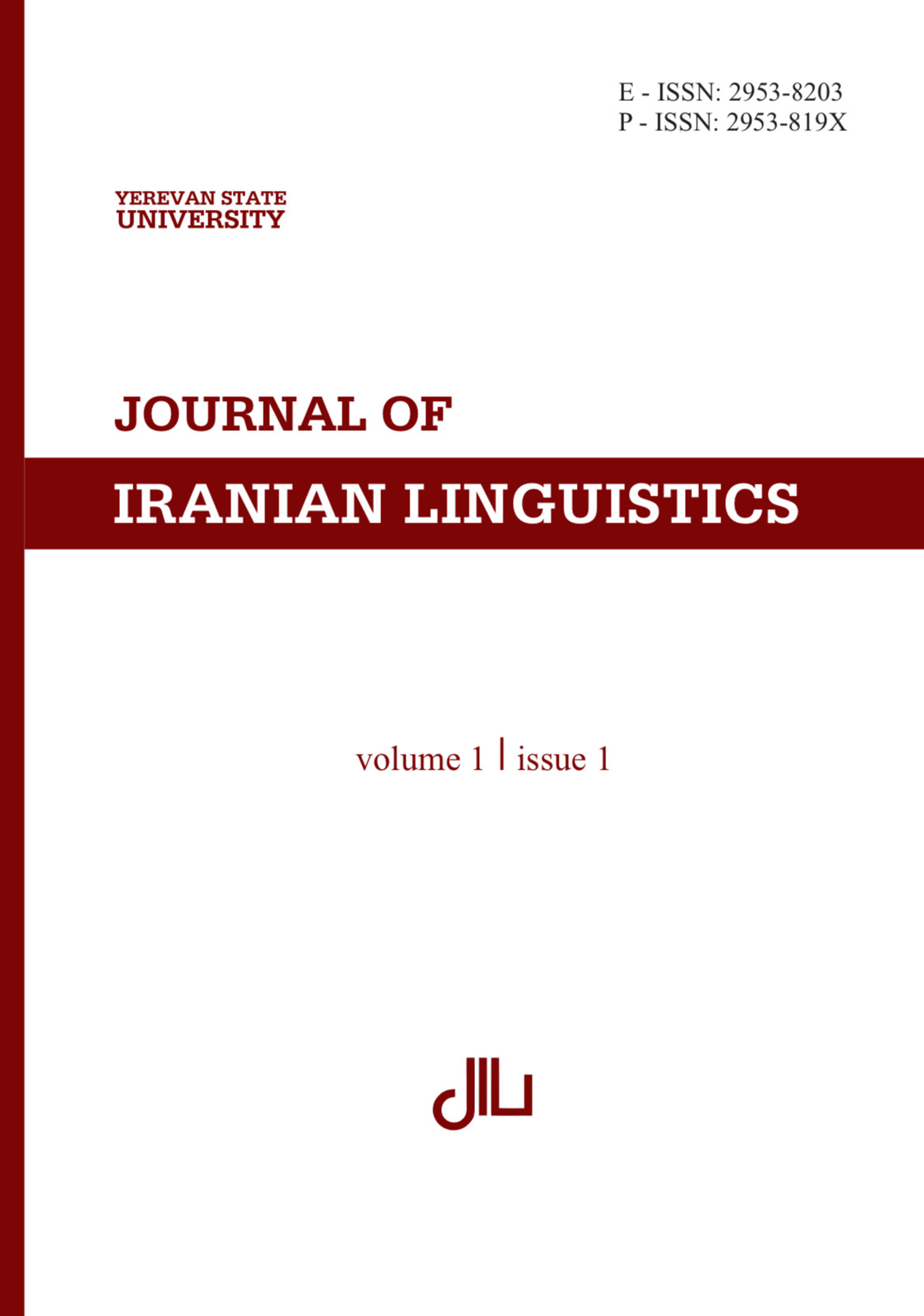EZAFE IN THE CONTEXT OF CPS: Evidence from three Iranian languages
DOI:
https://doi.org/10.46991/jil/2024.01.06Keywords:
Ezafe, Iranian languages, relative clauses (RCs), noun-complement clauses (NCCs), CPs, silent nounAbstract
The present study investigates the distribution of the Ezafe (EZ) morpheme in adnominal clauses in three Iranian languages, namely Persian, Kurmanji (Northern Kurdish), and Zazaki, demonstrating that the behavior of EZ in these languages challenges the case analysis of EZ, suggesting instead a compatibility with the inversion analysis of EZ. In contrast to the prediction made by the case analysis, it is shown that EZ is required before [–N] modifiers such as CPs. First, EZ is consistently used in restrictive relative clauses (RCs) in all three languages, with Persian using an allomorph of EZ in this context, contrasting with Kurmanji and Zazaki, which use the regular form of EZ. Non-restrictive RCs present divergence: while Persian does not allow EZ in this environment, Zazaki and Kurmanji employ regular and anaphoric EZ (AEZ) forms, respectively. Following de Vries (2006), non-restrictive RCs are treated as restrictive RCs with a silent head, aligning the distribution of EZ in these languages with its distribution after a silent noun: Persian lacks EZ here, while Zazaki and Kurmanji use EZ and AEZ, respectively. Second, in Noun-Complement Clauses (NCCs), Kurmanji and Zazaki consistently use regular EZ, while Persian offers two options: the allomorph of EZ used with CPs or no EZ at all. Two possible structures are proposed for NCCs, one with and one without inversion, attributing the distribution of EZ to the structure involving inversion. This study shows that EZ is present in CP contexts and its distribution in these languages follows from the general behaviour of EZ and the syntax of N-CP structures.
References
Cinque, G. (2002), The Functional Structure of DP and IP – The Cartography of Syntactic Structures, Vol. 1, Oxford: Oxford University Press.
Cinque, G. (2005), “Deriving Greenberg’s Universal 20 and its Exceptions”, Linguistic Inquiry, vol. 36, pp. 315-332.
Cinque, G. (2010), The Syntax of Adjectives: A Comparative Study, LI Monograph 57, Cambridge: MIT Press.
Dikken, M. den )2006(, Relators and Linkers, Cambridge: MIT Press.
Ghomeshi, J. (1997), “Non-projecting nouns and the ezafe: construction in Persian”, Natural Language & Linguistic Theory, vol 15(4), pp. 729-788.
Gündoğdu, S. (2023). ''Ezafe in Northern Kurdish'', Toronto Working Papers in Linguistics, vol. 45(1), pp. 1-16.
Gündoğdu, S., & Amine, B. (2023). ''Ezafe in Zazaki'', Toronto Working Papers in Linguistics, vol. 45(1), pp. 1-17.
Haig, G. (2011), “Linker, relativizer, nominalizer, tense-particle: On the Ezafe in West Irania”, Nominalization in Asian Languages: Diachronic and Typological Perspectives, pp. 363-390.
Haig, G. (2019), “The Iranian languages of northern Iraq”, in: The Languages and Linguistics of Western Asia: An Areal Perspective, Vol. 6, eds. Haig, Geoffrey & Geoffrey Khan, Berlin: Mouton de Gruyter, pp. 267-304.
Hankamer, J., and Mikkelsen, L. (2021), “CP complements to D”, Linguistic Inquiry, vol. 52(3), pp. 1-45.
Jambrović, S., and Mohammed, K. H. (2023), “Nominal linkers in Central Kurdish (Silemānī variety)”, Toronto Working Papers in Linguistics, vol. 45(1), pp. 1-18.
Kahnemuyipour, A. (2014), “Revisiting the Persian Ezafe construction: A roll-up movement analysis”, Lingua, vol. 150. pp. 1–24.
Kahnemuyipour, A., and Taghipour, S. (2024), “Ezafe in the context of PPs”, oral presentation at the Canadian Linguistic Association Annual Meeting, Carleton University, Canada.
Karimi, S. (2005), A minimalist approach to scrambling: Evidence from Persian, Berlin: Mouton de Gruyter.
Karimi, S., and Brame, M. (2012), “A generalization concerning the Ezafe construction in Persian”, Linguistic Analysis, vol. 38(1), pp. 111-144.
Krapova, I., and Guglielmo, C. (2015), “On noun clausal “complements” and their non-unitary nature”, Annali di Ca’ Foscari. Serie occidentale, vol. 50., pp. 77-107
Kratzer, A. (2006), Decomposing attitude verbs, Ms, University of Massachuetts, Amherst.
Larson, R., and Hiroko Y. (2008), “Ezafe and the Deep Position of Nominal Modifiers”, in: Adjectives and Adverbs: Syntax, Semantics and Discourse, eds. McNally, Louise & Christopher Kennedy, Oxford: Oxford University Press, pp. 43-70.
Larson, R., and Samiian, V. (2020), “The Ezafe construction revisited”, in: Advances in Iranian Linguistics, eds. Larson, Richard, Sedigheh Moradi & Vida Samiian, Amsterdam: John Benjamins, pp. 173-236.
Larson, R., and Samiian V. (2021), “Ezafe, PP and the nature of nominalization”, Natural Language & Linguistic Theory, vol. 39(1), pp. 157-213.
MacKenzie, D. N. (1961), Kurdish dialect studies I, Oxford: Oxford University Press.
McCarus, E. N. (2009), “Kurdish”, in: The Iranian Languages, ed. Windfuhr Gernot, New York: Routledge, pp. 587–633.
Moulton, K. (2009), Natural selection and the syntax of clausal complementation, Amherst, MA: University of Massachusetts dissertation.
Moulton, K. (2013), “Not moving clauses: Connectivity in clausal arguments”, Syntax, vol. 16(3), pp. 250-291.
Moyne, J., and Carden, G. (1974), “Subject reduplication in Persian”, Linguistic Inquiry, vol. 5(2), pp. 205-249.
Napoli, D. J. (1989), Predication theory: a case study for indexing theory, Cambridge: Cambridge University Press.
Samiian, V. (1994), “The Ezafe construction: Some implications for the theory of X-bar syntax”, Persian Studies in North America, pp. 17-41.
Samiian, V., and Larson, R. (2023), “Middle Persian ezafe”, in: Advances in Iranian Linguistics, vol.2, eds. Simin Karimi, Narges Nematollahi, Roya Kabiri and Jian Gang Ngui, Amsterdam: John Benjamins, pp. 100-129.
Samvelian, P. (2007), “A (phrasal) affix analysis of the Persian Ezafe”, Journal of Linguistics, vol. 43(3), pp. 605-645.
Shlonsky, U. (2004), “The Form of Semitic Noun Phrases”, Lingua, vol. 114(12), pp. 1465-1526.
Shlonsky, U. (2010), “The Cartographic Enterprise in Syntax”, Language and Linguistics Compass, vol. 4(6), pp. 417-429.
Skjærvø, P. O. (2009), “Middle West Iranian”, in: The Iranian Languages, ed. Windfuhr Gernot, New York: Routledge, pp. 196-278.
Stowell, T. (1981), Origins of phrase structure, Cambridge, MA: MIT dissertation.
Taghipour, S., and Kahnemuyipour, A. (2023), “Nominal Linkers in Iranian Languages”, Toronto Working Papers in Linguistics, vol. 45(1).
Vries, M. de (2006), “The syntax of appositive relativization: On specifying coordination, false free relatives, and promotion”, Linguistic Inquiry, vol. 37(2), pp. 229-270.
Downloads
Published
How to Cite
Issue
Section
License
Copyright (c) 2024 Songül Gündoğdu , Arsalan Kahnemuyipour, Marcel den Dikken

This work is licensed under a Creative Commons Attribution-NonCommercial 4.0 International License.


